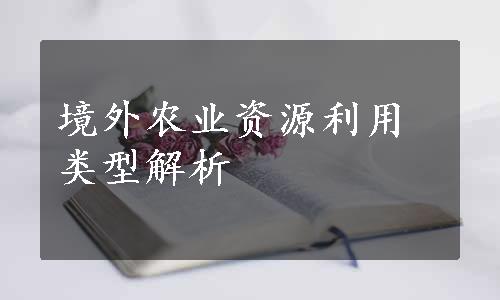
改革开放三十多年以来,我国境外农业资源利用发展步伐较快,尤其是近十年来,我国粮食作物等主要农产品进口逐年增加,加速了我国境外农业资源利用的步伐。然而,在展开本文研究之前,这里需要特别强调的是,当前我国境外农业资源利用的形式和手段主要分为两种:一是通过境外农业直接投资的形式利用境外农业资源;二是通过离岸价(Free On Board,简称FOB)或到岸价(Cost,Insurance and Freight,简称CIF)的形式从国际跨国粮油企业采购粮食等农产品,即境外农业资源利用的形式为农产品进口。从总体上来看,当前我国境外农业资源利用仍以农产品直接进口的形式为主(程国强,2014)[18]。
为便于行文简洁性,借鉴程国强(2014)、程国强和朱满德(2014)对我国境外农业资源利用研究中的界定[19],本文将境外农业资源利用的形式划分为两种类型:
一是,通过境外农业直接投资的形式利用境外农业资源,即所谓的直接利用目标国或地区的农业资源,本文将其统一界定为“境外农业资源直接利用”;
二是,通过从跨国粮食企业订货采购粮食等农产品的境外农业资源利用,即所谓的由进口来源国(或地区)在其资源禀赋条件下生产加工的粮食作物等农产品,我国通过国际大型粮油企业直接进口到国内市场满足国内消费需求,本文将这种境外农业资源间接利用形式统一界定为“境外农业资源间接利用,即粮食进口”[20]。
这里需要强调的是,本文界定了境外农业资源利用的类型,分为境外农业资源间接利用和境外农业资源直接利用。诚然,境外农业资源间接利用是当前我国境外农业资源利用的形式之一,为了保障本研究主题内涵的全面性,本文将主要研究重点放在境外农业资源直接利用的框架体系构建上,包括境外农业资源直接利用的主体培育、区位选择和风险识别与评价上。纵然,本文仅采用一章内容来考察中国境外农业资源间接利用与粮食安全的关系,但本文并未忽略境外农业资源间接利用这一问题在中国境外农业资源利用类型中的重要地位。
【注释】
[2]感兴趣的读者可参阅:VanekJ.,“The Factor Proportions Theory:The N-factor Case,”Kyklos,vol.21,no.4,1968.
[3]LeontiefW.,“Domestic Production and Foreign Trade;The American Capital Position Re-Examined,”Proceedings of the American Philosophical Society,vol.97,no.4,1953;G.C.Hufbauer,“The Impleaact of National Characteristics &Technology on the Commodity Composition of Trade in Manufactured Goods,”The Technology Factor in International Trade,UMI,1970;K.E.Maskus,“A Test of the Heckscher-Ohlin-Vanek Theorem:The Leontief Commonplace,”Journal of International Economics,vol.19,no.3-4,1985;A.M.James and B.T.Elmslie,“Testing Heckscher-Ohlin-Vanek in the G-7,”Weltwirtschaftliches Archiv,vol.132,no.1,1996.
[4]SchluterG.and G.K.Lee,“Is Leontief’s Paradox Applicable to U.S.Agricultural Trade?”Western Journal of Agricultural Economics,vol.3,no.2,1978;R.A.Brecher and E.U.Choudhri,“The Factor Content of International Trade Without Factor-price Equalization,”Journal of International Economics,vol.12,no.3-4,1982;C.Lee,D.Wills and G.Schluter,“Examining the Leontief Paradox in US Agricultural Trade,”Agricultural Economics,vol.2,no.3,1988;Wu,“An Investigation of the Leontief Paradox using Canadian Agriculture and Food Trade:An Input-Output Approach,”Theses of Master of Science,McGill University,2012.
[5]SchottP.K.,“One Size Fits All?Heckscher-Ohlin Specialization inGlobal Production,”American Economic Review,vol.93,no.3.
[6]SchluterG.and G.K.Lee,“Is Leontief’s Paradox Applicable to U.S.Agricultural Trade?”;C.Lee,D.Wills and G.Schluter,“Examining the Leontief Paradox in US Agricultural Trade.”;W.W.Koo and C.S.Anderson,“Effects of Resource Endowments on Agricultural Trade,”Agricultural Economics Report,North Dakota State University,no.239,1988;I.Fert,“Vertically Differentiated Trade and Differences in Factor Endowment:The Case of Agri-Food Products between Hungary and the EU,”Journal of Agricultural Economics,vol.56,no.1,2005;Wu,“An Investigation of the Leontief Paradox using Canadian Agriculture and Food Trade:An Input-Output Approach.”;J.Pokrivcak and M.Rajcaniova,“Crude Oil Price Variability and Its Impact on Ethanol Prices,”Agricultural Economics,vol.57,no.8,2011.
[7]SternR.M.,“Testing Trade Theories,”International Trade and Finance:Frontiers for Research.Cambridge,vol.197,no.8,1975.
[8]卢锋:《比较优势与食物贸易结构——我国食物政策调整的第三种选择》,《经济研究》1997年第2期。(www.xing528.com)
[9]详细可参阅以下两篇相关研究,第一篇是Leamer(1984)出版的专著“Sources of International Comparative Advantage:Theory and Evidence”,另一篇是Bowen,Leamer和Sveikauskas(1987)在“American Economic Review”发表的一篇著名论文“Multicountry,Multifactor Tests of the Factor Abundance Theory,.
[10]参阅帅传敏、程国强、张金隆(2003)在《管理世界》发表的论文《中国农产品国际竞争力的估计》;程国强(2004)于《管理世界》发表的论文《中国农产品出口:增长、结构与贡献》,程国强(2005)在《农业经济问题》上发表的《中国农产品出口:竞争优势与关键问题》一文。
[11]KielyteJ.,“Estimating Panel Data Models in the Presence of Endogeneity and Selection,”Journal of Economics and Econometrics,vol.51,no.2,2008.
[12]FeenstraR.C.,Increasing Returns and the Gravity Equation,in Advanced International Trade:Theory and Evidence,Princeton:Princeton University Press,2004.
[13]BalassaB.and L.Bauwens,“The Determinants of Intra-EuropeanTrade in Manufactured Goods,”European Economic Review,vol.32,no.7,1988.
[14]W.W.Koo and C.S.Anderson,“Effects of Resource Endowments on Agricultural Trade.”
[15]参阅卢锋(1996)的北京大学中国经济研究中心内部讨论稿系列(No.C1996005)《比较优势与食物贸易结构——我国食物政策调整的第三种选择》;J.R.Markusen,“Explaining the Volume of Trade:An Eclectic Approach,”The American Economic Review,vol.76,no.5,1986,pp.1002-1011;R.Jones,H.Beladi and S.Marjit,“The Three Faces of Factor Intensities,”Journal of International Economics,vol.48,no.2,1998.
[16]M.Fujita,P.R.Krugman and A.J.Venables,The Spatial Economy:Cities,Regions,and International Trade,Cambridge,MA:MIT Press,1999;D.Hummels,“Transportation Costs and International Trade in the Second Era of Globalization,”Journal of Economic Perspectives,vol.21,no.3,2007.
[17]Xilin Li,“Technology,Factor Endowmentsand China’s Agricultural Foreign Trade:ANeoclassical Approach,”China Agricultural Economic Review,vol.4,no.1,2012.
[18]参见程国强:《如何更好地利用境外农业资源》,《农经》2014年第5期。
[19]参见程国强、朱满德:《中国农业实施全球战略的路径选择与政策框架》,《改革》2014年第1期;程国强:《如何更好地利用境外农业资源》,《农经》2014年第5期。
[20]需要特别强调的是,关于术语“境外农业资源利用”下文行文中不再特别强调是境外农业资源直接利用或境外农业资源间接利用,当然仅在本文中便于陈述,“境外农业资源利用”意指“境外农业资源的直接利用”,“粮食进口”意指“境外农业资源的间接利用”。本文出于行文简洁性,仅在章节标题中分别表述为“境外农业资源直接利用”和“境外农业资源间接利用”,正文中采用“境外农业资源利用”和“粮食进口”来表述。
免责声明:以上内容源自网络,版权归原作者所有,如有侵犯您的原创版权请告知,我们将尽快删除相关内容。




